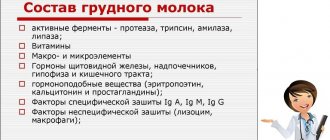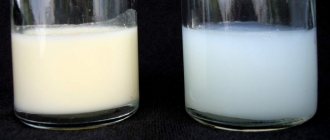Expert: Doctor of Medical Sciences, Professor, Honored Doctor of the Russian Federation, Head of the Department of Pediatrics named after G.N. Speransky "Russian Medical Academy of Continuing Professional Education" of the Ministry of Health of the Russian Federation Irina Nikolaevna Zakharova
Breast milk is by far the best nutrition for babies from birth. However, quite often it happens that the mother either does not have enough milk for full feeding, or simply does not have it. Or there are medical contraindications to breastfeeding. In this case, adapted mixtures based on cow's or goat's milk come to the rescue. Moreover, mixtures based on goat milk have become increasingly popular in recent years. This is due to the characteristics of goat milk protein.
What is the difference between goat's milk and cow's milk?
The composition of goat milk has a number of advantages:
- The protein composition of goat's milk is quite similar to cow's milk. The difference is that goat milk contains a smaller amount of one of the protein fractions - alpha-S1-casein. Due to this, goat milk proteins form a softer and more delicate curdled clot in the stomach, which is easier to digest by the child’s immature gastrointestinal tract.
- Goat's milk fats have a higher content of short- and medium-chain fatty acids and are small fat globules (balls), unlike the fat composition of cow's milk, so they are easier to digest and absorb by the body.
- “Goat product” contains more vitamin A and B vitamins and minerals such as Ca, P, Mg, K, Mn, Zn, Se, compared to cow product. But it is low in iron and folic acid.
- As for the carbohydrate composition, goat milk contains 10 times more oligosaccharides than cow milk. Oligosaccharides, being food for the microbiota of the large intestine, stimulate its growth and vital activity.
Goat's milk in baby food: what to choose, whole product or adapted mixtures?
Goat's milk as part of baby food is becoming increasingly popular in the recommendations of pediatricians and allergists. The microelement composition and characteristics of fats reduce the risks of allergies and kidney pathologies; goat's milk is a source of the “right” calories and nutrients. But is goat milk always harmless? At what age can a child drink milk, and when is it better to continue breastfeeding or formula feeding, says pediatrician Ekaterina Andreevna Yakovleva. In any case, before offering your child whole milk, ask a pediatrician who has been observing your baby since birth and knows the individual characteristics of his body.
— Ekaterina Andreevna, how does goat’s milk differ from cow’s milk and what are the benefits of goat’s milk for the body?
— Goat’s milk is considered more useful in a number of respects than cow’s milk. It is closer in type of secretion and protein composition to breast milk, therefore it is easier to digest and assimilate by young children.
In addition, goat's milk has a protective effect on the gastrointestinal mucosa and is often suitable for children with a strong family history of cow's milk protein allergy. However, if an allergy has already been diagnosed in a child, then goat milk proteins may not always be suitable - only a small percentage of children can do without hydrolyzed formulas and avoid dairy products.
— Is it true that it is better to drink milk within twenty to thirty minutes after milking, otherwise it will lose its beneficial properties?
— In the modern world, it is difficult to imagine drinking goat or cow milk within half an hour after milking, since all milk is produced on farms and factories. It goes through a sterilization or pasteurization process and only then is it bottled and sent to stores. During processing, milk slightly loses its properties, but this does not make it of little value. Fresh milk is only better if it comes from a proven healthy animal.
— Is natural goat milk considered hypoallergenic?
— Goat’s milk cannot be called completely hypoallergenic, since cross-allergy with cow’s milk occurs due to the content of a certain amount of similar proteins in goat’s milk. Therefore, if a child has a very severe allergy to various cow's milk proteins, the child may also be allergic to goat's milk. But if there is a reaction to only one type of protein, then goat’s milk can easily replace cow’s milk.
Goat's milk is less likely to cause allergies than cow's milk.
Supplementary feeding and complementary feeding with goat's milk for an allergy to cow's milk protein (CMP) in an infant
Severe hypersensitivity to CMP
| Mild allergy to BKM
| The risk of developing an allergy to CMP with a complicated medical history
|
Children with a known allergy to cow's milk protein are not recommended to be fed goat's milk formula because it cross-reacts.
— Do all children like the taste of goat milk?
— Children initially do not have taste preferences: in fact, they are a blank slate. Since they are not given food with salt and sugar during complementary feeding, they know the true tastes of foods. And preferences depend on the kids - some like the taste of goat's milk, others don't. But, most likely, if you initially give goat’s milk, the child will take it for granted, and he will like the taste, because he doesn’t know anything else.
— What baby food with goat milk do manufacturers offer?
— For newborns and older babies, these will be adapted milk formulas of the first, second and third stages. In addition, “goat” products for complementary feeding are produced - milk porridge, baby cottage cheese, fruit curds, yoghurts, vegetable cream soups.
— At what age is goat milk allowed to be given to infants?
— Any whole milk (goat, cow, sheep) is not recommended for at least a year. Until this age, milk nutrition should be represented by breast milk or an adapted formula. In addition to milk, the formula contains micro and macronutrients necessary for a child at this age. In addition, the adapted mixture significantly reduces the risk of allergies compared to whole milk.
Milk for children over one year old
| Breastfed | Artificially fed | |
| It is advisable to wait and breastfeed as long as possible. | If it is not possible to give formula, but the child has a varied and complete diet, then you can try whole goat milk. | If the child does not eat complementary foods well or is not gaining weight, then it is better to continue feeding with the third formula (baby milk 12+). |
| Breastfed It is advisable to wait and breastfeed as long as possible. | Artificially fed If it is not possible to give formula, but the child has a varied and complete diet, then you can try whole goat milk. If the child does not eat complementary foods well or is not gaining weight, then it is better to continue feeding with the third formula (baby milk 12+). |
Why can't you feed a young child whole goat's milk?
- not adapted for protein and fat composition;
- the quantity and ratio of macro- and microelements does not correspond to the baby’s age standards;
- few vitamins, many minerals;
- risk of developing anemia and rickets;
- adulteration of liquid goat milk by unscrupulous producers by diluting it with cow's milk;
- It is unacceptable to consume goat milk from animals that have not undergone full veterinary control!
— Ekaterina Andreevna, how does goat milk in adapted milk formulas differ from whole goat milk?
— The amount of protein in the formulas is reduced, the ratio of whey protein and casein is close to human milk and adapted to the age of the child. The product is enriched with vitamins, iron and other macro- and microelements. Therefore, the absorption of goat mixtures is easier, they have a gentle effect on digestion and can replenish all deficient conditions.
Regular animal milk is unable to meet all the needs of a child in the first year of life. But the most unfavorable effect of whole milk is the significant stress that its components place on the liver, kidneys and other organs of a small child.
— Can goat milk formula replace breast milk?
— Infant formula can be as close as possible to natural nutrition if its formula is adapted and enriched not only with vitamins and minerals, but also with functional substances, for example: pro- and prebiotics, lutein.
— What is the difference between infant formulas made with goat’s and cow’s milk?
— The main difference is in the raw materials. The structure of proteins and lipids (fats) in goat's milk is different from the structure of proteins and lipids in cow's milk. Goat's milk is more adapted to the characteristics of the digestive system of newborns and babies. Goat's milk fat globules are small and easily digested by enzymes, which helps form soft stools similar to those of breastfed babies. In addition, unlike cow's milk, goat's milk contains virtually no allergenic protein component α-s1-casein.
Goat milk formulas are not medicinal. Typically, specialized formulas, such as anti-reflux formulas or hydrolysates, are made only from cow's milk. Otherwise, it is more logical to compare certain brands - manufacturers try to improve and add useful components to their products, so all mixtures are slightly different.
How MAMAKO® Premium adapted goat formulas differ from other infant formulas based on goat milk
| Rapeseed and palm oil excluded: Goat milk lipids contain palmitic acid, similar in structure to the acids in breast milk, which contributes to the formation of soft stools. | Protein levels are reduced, and the ratio of whey proteins to casein is the same as in breast milk, which helps maintain kidney health and better digestion of nutrition. | There is an IQ complex: the mixture contains Omega-3 (DHA), Omega-6 (ARA) fatty acids and lutein - valuable components for the development of intelligence and vision. | They contain nucleotides, pre- and probiotics: additional components that support immunity and intestinal microflora. |
Goat's milk is considered healthier than cow's milk. It protects the mucous membrane of the gastrointestinal tract and is less likely to provoke allergies. If your baby is allergic to cow protein, you should also be careful with goat milk and products based on it and give them only under the supervision of an allergist. It should be remembered that whole milk should absolutely not be introduced into the diet of children before one year of age - and it is better to postpone its use until at least one and a half years. Until this time, you should continue breastfeeding or an adapted formula.
Pediatrician Ekaterina Andreevna Yakovleva
*The ideal food for an infant is mother's milk. WHO recommends exclusive breastfeeding for the first 6 months. MAMAKO® supports this recommendation. Before introducing new foods into your baby’s diet, consult a specialist.
Is it possible to give goat milk to a child?
Yes, as mentioned above, whole goat milk is a healthy and easily digestible product with high nutritional value, but it is not suitable for a baby as food. After 6 months, according to the National Feeding Program, whole cow (goat) milk is allowed in small quantities in the diet (as an additive to porridge, for example), but it is still better to introduce whole milk to your baby after a year.
- Goat's milk contains a lot of protein and mineral salts, which creates a high load on the baby's immature intestines, kidneys and pancreas.
- Whole goat milk protein is as common and strong an allergen in the first year of life as cow's milk protein.
- After a year, the situation changes; in most cases, the baby’s immune system is ready to gradually encounter various allergens, and whole goat’s milk in acceptable quantities is usually well tolerated.
What do scientists say about the testing of infant formula based on goat milk?
Some of these formulas were tested at the Department of Pediatrics of the Russian Medical Academy: scientists assessed the clinical effectiveness of adapted formulas based on goat's milk, which were fed to children of the first year of life and who had functional gastrointestinal disorders - frequent regurgitation, intestinal colic, constipation.
As experts noted, no cow's milk is added to these mixtures, which makes them more friendly to the infant's immature digestive system. The fat profile of such mixtures is also adapted - they have added a special fat complex containing 42% palmitic acid, which is the dominant fatty acid in breast milk. Clinical studies of this component have shown that it helps normalize digestion, improve calcium absorption and increase energy metabolism. In general, palmitic acid promotes normal bone mineralization and reduces the incidence of constipation.
There are also mixtures that are additionally enriched with probiotics and nucleotides. Studies conducted at the Russian Medical Academy have shown that such formulas are well tolerated by bottle-fed babies, and most of them get rid of functional disorders of the gastrointestinal tract.
Myths about goat milk
Myth 1.
Goat's milk can't be boiled.
This is not true. Such a product can cause various infections, as it may contain various viruses (for example, hepatitis A or tick-borne encephalitis, to which goats and sheep are susceptible), bacteria (staphylococcus, Brucella) and fungi (Candida). Therefore, boiling is the only way to disinfect milk purchased at the market or homemade.
Myth 2. Goat milk has an unpleasant smell and taste.
It is not true. A clean goat, as a rule, produces tasty milk without taste or odor. The animal's nutrition is also important. Some herbs can give a bitter taste.
Myth 3. Goat milk for children needs to be diluted with water.
This is true. When first introducing goat milk into the diet and introducing the baby to goat milk, it is possible to dilute it with water 50:50 and see the body’s reaction and tolerance. Subsequently, the amount of water for dilution can be reduced and gradually switch to whole goat milk.
Should I alternate milk and formula?
If it is impossible to breastfeed, preference is given to formulas whose composition is adapted and enriched with vitamins and microelements according to the baby’s age.
Goat milk for up to a year can be given as an additional food: prepare porridge, kefir, yogurt or cottage cheese with it, and offer the milk itself in diluted form after meals once a day.
But there is a problem: the baby’s digestive system adapts to the digestion and absorption of basic nutrition, and regular alternation of formula and goat’s milk can disrupt this process.
Infant formula with goat milk.
Contraindications to drinking goat milk
Among the restrictions on the consumption of milk drinks in childhood are:
- hypersensitivity to the composition of the product;
- avitaminosis;
- excess body weight;
- kidney pathologies;
- tendency to develop anemia;
- diseases of the endocrine system.
When feeding a child with this product, supplements containing iron should be used (after consultation with the pediatrician), and body weight should be monitored. Infants should not be given goat's milk from infected animals, as this can lead to serious consequences.
Goat milk cottage cheese recipe
If your baby refuses to eat goat's milk, prepare cottage cheese. The cottage cheese turns out tender and without lumps, and if you add a little honey or sugar to it, it becomes unusually sweet.
Step-by-step instructions for preparing cottage cheese:
- Heat a liter of goat's milk in an enamel bowl to approximately 40 degrees Celsius.
- Separately, dilute 700 grams of low-fat yogurt with a small amount of goat milk.
- Add the resulting mixture to the warm milk and mix thoroughly.
- Remove the pan from the heat and leave overnight. It is advisable to wrap it in a blanket.
- In the morning, when the mixture thickens, stir it and heat it over low heat, stir after 20 minutes, then bring to 80 degrees and set aside from the heat.
- Place in a large container of cold water, occasionally changing the water with new water, until the mixture has cooled completely.
- Pour the mixture into a colander lined with a cloth that allows liquid to pass through. Tie the fabric on top and put it in the refrigerator for a day.
Periodically drain off the released whey. As soon as the cottage cheese reaches the desired consistency, you can eat it. Add honey, sugar or syrup to your child’s plate, creating new tastes.
The benefits of goat milk for the body of children
The most valuable product for infants is mother's milk, which saturates the child's body with useful microelements and ensures its full development. However, there are times when a mother cannot feed her baby breast milk, for example, if she has problems with lactation.
Beneficial properties of goat milk for children:
- Formation and strengthening of bones and teeth.
- Ensuring metabolic processes.
- Restoration of intestinal microflora.
- Improved appetite.
- Strengthening the body's protective qualities.
- Neutralization of hydrochloric acid in the stomach.
- Therapy and prevention of hyperacid gastritis.
- Increased physical endurance.
- Elimination of dermatitis of an allergic nature.
- Normalization of the functioning of the cardiovascular and digestive systems.
- Acceleration of wound healing processes, fusion of bone tissue in fractures.
- Saturating the body with energy and valuable microelements.
- Prevention of rickets.
- Preventing allergic reactions.
Goat's milk has a general strengthening, anti-inflammatory, wound-healing effect, so it can be used to treat ulcerative lesions of the stomach and/or duodenum, gastritis with high acidity.
The benefits of goat milk for children are due to its rich chemical composition:
| Name of valuable microelement | Main action |
| B vitamins | Increasing stress resistance, normalizing the activity of the digestive system, central nervous system, stabilizing the level of sugar elements in the blood, ensuring energy metabolism. |
| A | Stabilization of the functioning of the visual system, increasing the protective qualities of the body, regulating protein synthesis, ensuring metabolic processes, improving the structure of the epidermis, hair, wound healing. |
| E | Slowing down the aging process, maintaining the health of the visual and nervous system, stabilizing cardiac activity, normalizing the level of “bad” cholesterol in the blood. |
| D | Ensuring complete absorption of calcium, magnesium, phosphorus, preventing rickets, osteoporosis, strengthening the immune system, maintaining normal blood clotting, improving thyroid function. |
| K | Normalization of kidney activity, participation in metabolic processes, assistance in the body’s absorption of calcium and vitamin D, cleansing the body of toxic compounds. |
| C | Improving mood, eliminating depressive conditions, increasing immune qualities, therapy and prevention of colds, ensuring tissue respiration. |
| Sodium (Na) | Ensuring metabolic processes, stabilizing osmotic pressure, improving the functioning of the central nervous system. |
| Calcium (Ca) | Formation and strengthening of tooth enamel, bones, stabilization of heart rate, blood pressure, normalization of the endocrine system. |
| Zinc (Zn) | Healing wounds, enhancing protective properties, normalizing hormonal balance, saturating the body with energy, preserving youth. |
| Potassium (K) | Regulation of water balance, stabilization of heart rate, stimulation of brain activity, saturation of cells with oxygen. |
| Copper (Cu) | Relief of inflammatory processes, assistance in the production of collagen, strengthening bones, stabilizing the functioning of the thyroid gland, maintaining the functioning of the digestive system. |
| Magnesium (Mg) | Improving the functioning of the muscular and central nervous systems, strengthening teeth, preventing urolithiasis, normalizing the functioning of the gastrointestinal tract. |
| Phosphorus (P) | Protein synthesis, maintaining muscle and mental activity. |
| Iron (Fe) | Increasing hemoglobin levels, therapy and prevention of iron deficiency anemia, removing toxic substances from the body, ensuring hematopoiesis. |
| Manganese (Mn) | Reducing the level of sugar compounds in the blood, preventing diabetes, stimulating brain activity, stabilizing the functioning of the nervous system and pancreas. |
| Selenium (Se) | Prevention of the appearance of malignant neoplasms, improvement of the appearance of hair, epidermis, nail plates. |
It is advisable to consume the fresh product immediately after milking the goat. Before giving the drink to young children, it is necessary to boil it and dilute it with boiled water. Goat's milk differs from cow's in its hypoallergenic composition and contains a minimal amount of lactase, which often provokes undesirable reactions from the child's body.
Why is it not suitable for newborns?
We found out that goat's milk is healthier for the child's body and is easier to digest. Let's talk about whether it can be considered as a separate product when we talk about the menu for a newborn baby. Many doctors are against introducing animal milk into the diet, and there are several reasons for this:
- Casein is present in large quantities, it is poorly absorbed by the still fragile body, which can lead to the formation of clots in the stomach, causing discomfort to the child. However, the content of alpha-1s-casein is practically zero, and it is this element that provokes allergic reactions in people to cow's milk.
- There is virtually no folic acid and iron, which can lead to anemia, problems with hematopoiesis and other diseases.
- A high content of mineral salts is harmful to the baby’s body, since his kidneys and liver are not yet strong enough and are not accustomed to such stress.
- The high concentration of fats makes the product nutritious, but at the same time “heavy” to digest, since there is no lipase that helps digest fats.
We reveal the question: Potatoes on the menu during breastfeeding
There are many positive stories about infants using this product, but before you decide to give it to your child, take into account all of the above points. Pediatricians agree that this is not the best product for constant feeding.











